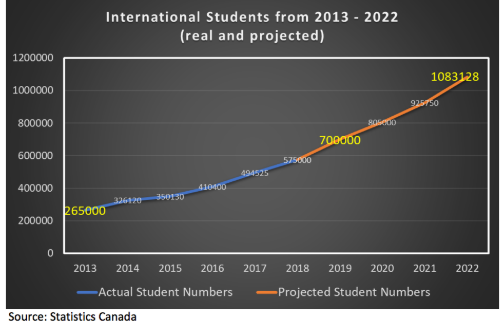An American colleague of mine sent me a note the other day. “So…Canada is heading to a million foreign students? That’s huge!”
To which my reaction was: “Wut? Dude, it’s about a quarter of that.”
At which point my colleague emailed me a recent story from ThePIE, a nifty little London-based outlet which covers international education. It was called Will Canada have quadrupled its student numbers in eight years? by Dave Sage, who appears to be some kind of immigration and education consultant. The article went on to claim that if Canada hit a million students, then we would have almost as many as the United States, woo Canada, etc.
I shook my head when I read it but was secretly pleased. An opportunity to nerd out on the disastrously uncoordinated states of Canadian international student statistics! What could be better?
Here’s the deal. The data Sage is citing is produced by Immigration, Refugee and Citizenship Canada (IRCC) and counts the number of student visa approvals. These have indeed been growing very quickly as the following graph shows. The 2019 numbers projected for 700,000 and at a similar rate of growth is headed to over 1 million just three years from now.

The thing is, though, that “visa holders” and “international students” are not the same thing. Statistics Canada, for instance, shows the number of international students in Canadian universities and colleges as 245,000 for 2016-2017, or only a bit more than half of what the visa numbers claim.
Why the differences? Well, the IRCC numbers include a whole bunch of things the Statscan ones don’t. For instance, IRCC counts:
- Students enrolled in primary or secondary education for periods longer than 6 months. Statscan does not include these.
- Students enrolled in “postsecondary education”, which includes “university”, “college” and “other”. “Other” is painfully under-described in all the documentation I’ve ever seen, but my understanding is that it includes language courses, and probably technical/vocational education as well. Statscan does not include these.
- Students classified as “Other”. Yes, really, a second “other” category and again, painfully under-described but my understanding is that this may includes any spouses of students who have applied for open work-permits. Statscan does not include these.
In total, only about 72% of the “international” students are registered as “post-secondary” (as of 2018 that figure was 491,000), and of course a significant portion of those may be language students. In addition, it’s worth remembering that not everyone who gets a visa actually shows up and not everyone who shows up stays in school until the end of their visa period. So, the relationship between visa holders and post-secondary students as we think of them is a long way from one-to-one.
That said, there seems to have been a reasonably stable relationship between “post-secondary visas” (the IRCC definition) and “international post-secondary students” for most of the past decade. In figure 2, I show the IRCC figure for post-secondary visas (for some of the earlier years where the breakdown between destinations was unavailable, I simply multiplied total student visas by .72, which, for the last few years, has been the stable ratio between the two), and the Statscan count of enrolled international students. Turns out the IRCC figure was reliably between 8-14% larger than the Statscan figure until 2016 when it suddenly jumped to 20%.
Figure 2: IRCC vs. Statscan counts of International Students

Now this graph got me thinking: 2016 is also when visa numbers exploded – between 2016 and 2018, current visas at the end of Q3 rose by just over 55%. Though we have no “official” Statscan data on international student enrolments, a quick look at internal institutional reports can nevertheless give us a pretty good sense of what is going on. I checked the stats at Toronto, UBC, York, McGill and Ottawa – five institutions which collectively took in a quarter of all international PSE students in 2016. Turns out that on average, their increase in international student numbers was only about 20%. Which means that the gap between visa international students and Statscan international students had grown from about 50,000 to 160,000 or so. Some of the difference presumably is made up by language school students – but Languages Canada (the language school industry’s representative body) isn’t reporting anything like that rate of growth.
Which makes a fair bit of that growth a complete mystery. “Postsecondary” visas are being issued at a record rate but it’s not clear that they are actually showing up in any institutions in equivalent numbers. This is something to pay close attention to when the 2017/18 Statscan enrolment numbers come out in December.
In sum: yes, international enrolment in Canadian post-secondary institutions is rising. No, it’s nowhere near 700,000 and it is not hitting one million per year any time in the foreseeable future, let alone 2022.
Have a good weekend.

 Tweet this post
Tweet this post

Hi Alex,
Why all the animosity? Whether the facts are derived from IRCC or Statistics Canada does nothing to take away from the point of my article, which you clearly have missed.
Dave